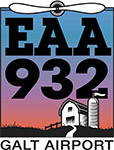Some airports don’t have any weather reporting but the ones that do have various types of AWOS or ASOS. These systems differ by level of sophistication and therefore usefulness to pilots.
Automated weather observing systems (AWOS) use an array of weather sensors, voice synthesizers and radio transmitters to continuously provide real-time weather that updates every minute. It is sometimes referred to as “the 1-minute weather.”
You can listen to the current weather broadcast on VHF radio frequencies in the airplane or by phone on the ground.
This 1-minute weather report will be more up to date than what you might see in ForeFlight. This is because ForeFlight only displays the routine weather observations (METARs) that are issued by AWOS systems every 20 minutes, at 15, 35 and 55 minutes past each hour. It can take several minutes for ForeFlight to retrieve the information through their interface with NOAA, parse the data and add it to their database before it is displayed in the app, which means that their weather can be as much as 26 minutes old.
Here is a list of the various options of AWOS that are available;
- AWOS-A: Only reports the altimeter setting
- AWOS-AV: Reports an altimeter setting and visibility
- AWOS-1: Altimeter, wind speed, direction and gusts, temperature and dew point
- AWOS-2: Same as AWOS-1 plus visibility
- AWOS-3: Information provided by AWOS-2 and includes cloud and ceiling data
- AWOS-3P: Same as AWOS-3 with added precipitation data
- AWOS-3PT: AWOS-3P with added thunderstorm/lighting reporting
- AWOS-4: Provides all the same information as AWOS-3PT and includes precipitation occurrence, type and accumulation, freezing rain, and runway surface condition
Automated surface observing system (ASOS) is a network of monitoring stations located at airports across the country. They are more sophisticated than AWOS and include the observations required to generate a routine weather report (METAR). METARs are usually updated hourly but ASOS can report special observations (SPECI) if weather conditions change more rapidly. In addition to the METAR pilots can obtain more immediate weather data by listening on the published frequency (when available) or by phone.
In addition to all the information provided by AWOS-4, ASOS can also measure and report on wind shifts, peak gusts, and rapid pressure changes. An ASOS visibility sensor is usually located near the touchdown zone of the primary instrument runway.
Frequencies for AWOS and ASOS are listed on the VFR sectional and in the Chart Supplement and phone numbers are only listed in the Chart Supplement. This information is also readily available to pilots in ForeFlight under the Info tab for each airport.
You might be wondering “why don’t all airports have an AWOS or ASOS?” and the answer is, of course, cost. These systems range in price from $20,000 to $100,000 which is prohibitive for many smaller and privately owned airports.
Beth Rehm, CFI

